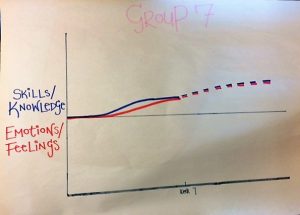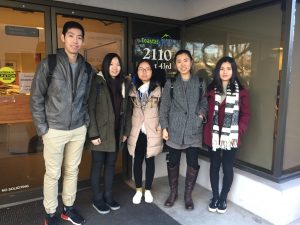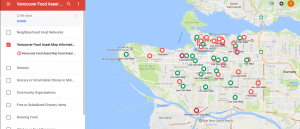What?
The Food Asset Map may be difficult to use for some with so many cluttered information, especially for those with a language barrier. It may be difficult for many immigrants to access food that they find culturally acceptable upon their arrival to Vancouver. A translated instruction video could teach these food insecure people how to use the Food Asset Map and ultimately, access food they deem culturally acceptable.
After completion of both a Chinese and English version of the Food Asset Map instruction video, we went into the community to trial it. Our aim was to found out how it can improved to better cater to the community members who would actually be using this tool. We went to Vancouver Neighbourhood House to meet with 7 Chinese speaking seniors. Most of these seniors spoke both Cantonese and Mandarin. During the trial, we first showed our audience the video and opened up the floor for them to ask questions and give feedback. We had them fill out a feedback form afterwards but they had difficulty with it as it was in English. With further translation and guidance, we were able to obtain solid feedback from a small sample from the community. A big issue that kept popping up with each of the surveyed individuals was that the even though the instruction video was in Chinese, the actually Food Asset Map and the information on it was still in English.
We trialed the English video on another day with fellow students at UBC. The feedback was very positive as the was no language hurdle and a majority of our sample reported that they would use it in the future.
We are finalizing our objectives and pooling all the data that we collected to present it to our class and community partners. In addition, we will begin writing our final report and have completed our infograph which will give our audiences clear and concise information regarding our project.
So What?
With this trialing process and the feedback from our surveyees, we hope to relay this information to those who work on the food asset map for them to improve upon the tool and to also improve upon the instruction video to make it clearer for all. We also hope to mitigate the difficulty of being food secure by reducing any language barriers towards the Chinese.
Now What?
According to the Business Inside, Vancouver is one the 3rd most expensive city to live in in the world and 13% (Holmes, 2017) of its households experience food insecurity on top of the the big food security problem in Downtown East Side. The Food Asset Map could help everyone in the community, especially the food insecure. The next steps will be to continually improve access and clarity of the map both directly and indirectly through our video. Having the people know that such a tool is available for their use and improving awareness of the food insecurity issues amongst them would also be important part of future plans. We hope to expand to other languages to accommodate more cultures and ethnicities in the future. The last thing we would want is for a family to not be able to find affordable food because they couldn’t understand or had no knowledge of our Food Asset Map.



